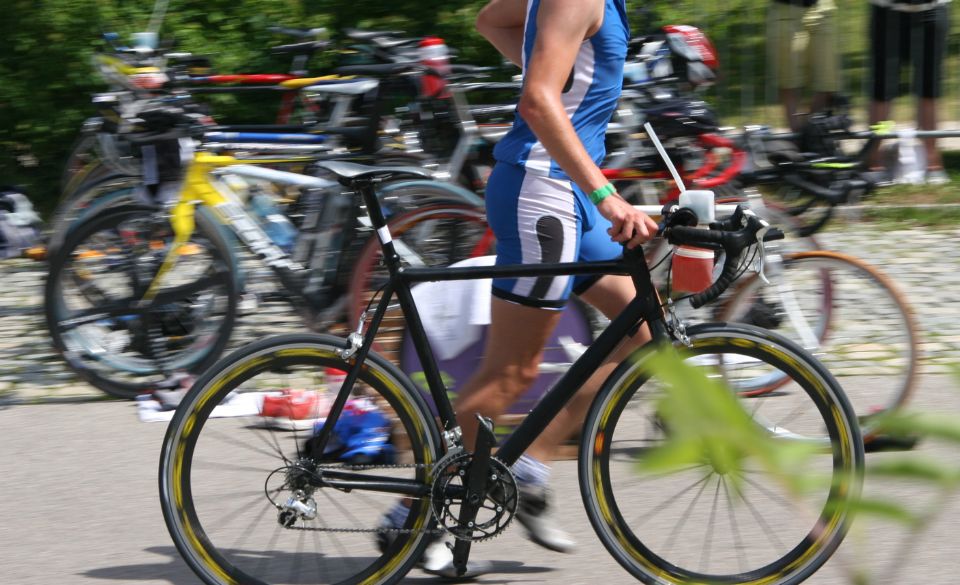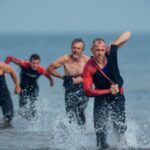
Triathlon Bike Mounting Techniques: Tips and Strategies to Improve Transitions
Page Contents
Triathlons are multi-discipline events that require athletes to swim, bike, and run in succession. The transitions between each stage of the race are crucial and can make a significant impact on the overall race time. In this article, we will focus on the bike mounting technique in triathlons and provide tips and strategies to help triathletes improve their transitions.
The Flying Mount
The flying mount technique is one of the most common and efficient ways to mount your bike during a triathlon. This technique involves approaching the bike at a running pace, grabbing the handlebars, and leaping onto the bike while simultaneously swinging your leg over the saddle.
To execute a flying mount, begin by jogging towards your bike with your cycling shoes already clipped into your pedals. Grab the handlebars with one hand, swing your leg over the saddle, and land on the bike seat while simultaneously pushing off the ground with your other foot. As you land on the bike, clip in your other foot and start pedaling.
The flying mount technique requires practice, but it can save valuable time during transitions and give you an edge over other competitors.
The Running Mount
The running mount technique is another option for triathletes who may not be comfortable with the flying mount or who have difficulty executing it. This technique involves running alongside your bike, jumping onto the saddle while still running, and then clipping in your feet as you start pedaling.
To perform a running mount, begin by jogging alongside your bike and grabbing the handlebars. Then, lift your leg and swing it over the saddle while still running. As you land on the saddle, clip in your first foot and then your second foot before starting to pedal.
While the running mount technique may not be as fast as the flying mount, it is a reliable option for triathletes who prefer a more conservative approach.
The Standing Mount
The standing mount technique is a variation of the running mount that is ideal for triathletes who have difficulty lifting their legs high enough to clear the saddle. This technique involves standing next to the bike, placing one foot on the pedal, and then pushing down on the pedal to propel yourself onto the saddle.
To perform a standing mount, begin by standing next to your bike with the pedals level. Place one foot on the pedal, push down, and swing your other leg over the saddle while still standing. Once you are on the saddle, clip in your feet and start pedaling.
The standing mount technique is an effective option for triathletes who struggle with the jumping motion required for the flying and running mounts.
How To Improve Your Bike Transition
In triathlons, transitions between each stage of the race can make a significant impact on the overall race time. Improving your bike transition is essential to ensure a smooth and efficient changeover from the swim to the bike leg. Here are some tips to help you improve your bike transition time:
Plan Ahead
Before the race, visualize your transition process and plan out the order of your gear. This can include laying out your helmet, sunglasses, cycling shoes, and any other equipment you need in a specific order. By planning ahead, you can save valuable time during the transition process.
Practice Your Transitions
Practice makes perfect, and the more you practice your transitions, the more efficient you will become. Set up a mock transition area and practice your bike mount technique, gear placement, and transition process. This can help you identify any areas that need improvement and help you become more familiar with the transition process.
Use Elastic Bands
One way to save time during your transition is by using elastic bands to hold your cycling shoes in the proper position. By using elastic bands to pre-position your cycling shoes on the bike, you can slip your feet into the shoes while riding, rather than wasting time trying to put them on during the transition.
Wear Your Gear
To save time, wear your gear under your wetsuit during the swim leg. This can include your cycling shorts, triathlon top, and any other equipment you need for the bike leg. By wearing your gear during the swim, you can save valuable time during the transition and get on your bike faster.
Know Your Bike Route
Familiarize yourself with the bike route before the race. This can help you prepare mentally and physically for the course, and ensure you are ready to tackle any hills or sharp turns. By knowing the route, you can also plan your gear and equipment accordingly, such as choosing the appropriate gear ratio for the terrain.
Keep It Simple
Keep your transition area simple and clutter-free. Only bring the gear and equipment you need, and avoid unnecessary items that can slow you down. By keeping your transition area organized and efficient, you can save valuable time and ensure a smooth transition.
In conclusion, improving your bike transition in triathlons requires preparation, practice, and efficiency. By planning ahead, practicing your transitions, using elastic bands, wearing your gear, knowing your bike route, and keeping it simple, you can improve your bike transition time and achieve your best race results.
Conclusion
In conclusion, the bike mounting technique is an essential skill that can make a significant impact on your transition time in triathlons. By practicing and mastering the flying, running, or standing mount, you can improve your transition time and gain an advantage over other competitors.
Remember to experiment with different techniques to find the one that works best for you and to practice regularly to improve your skills. With dedication and focus, you can achieve your best race results and reach your triathlon goals.



